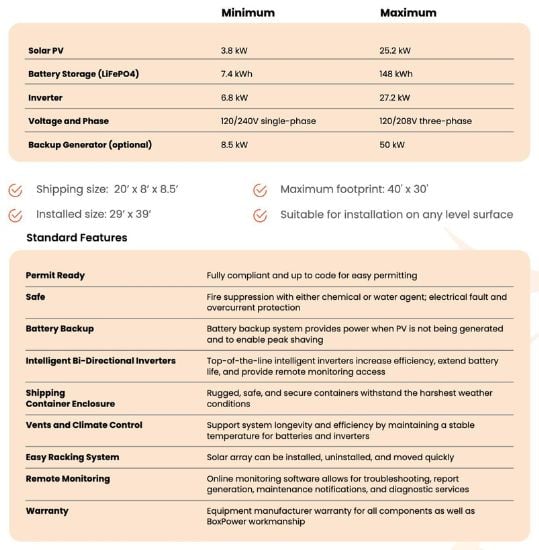Remote Grids Replace Distribution Lines to Combat Wildfire Risk
A renewable standalone power system just came online in a wildfire-prone area in rural California, replacing nearly 1 mile of overhead distribution lines. Here’s how it works.
California’s largest utility, Pacific Gas and Electric Company (PG&E), recently commissioned a pre-engineered remote microgrid featuring a 17.36 kW DC canopy solar array, a 27.2 kVa inverter, and a 60.8 kWh battery energy storage system (BESS) in a 20-foot shipping container.
The container for PG&E’s standalone remote power system. Image used courtesy of PG&E
The solar-plus-storage system replaces nearly a mile of overhead distribution lines, reducing wildfire risk. By swapping out physical infrastructure with a remote system, PG&E minimizes the chances of wildfire ignition in the 3,200-acre Pepperwood Preserve, impacted by fires in 2017 and 2019. The grid is 100% renewable and powers the preserve’s Bechtel House for overnight visitors without requiring fossil fuel-based backup generation.
Remote grids provide standalone energy resources to help utilities reduce fire ignition and support backup generation when public safety power shut-offs are required in dry conditions with high fire danger. This is cheaper than the typical system-hardening route, where utilities spend millions to replace bare or uninsulated power lines, place lines underground, and install stronger poles. Microgrids can operate connected to and synchronous with the local power grid as a group of interconnected loads and distributed energy resources. They can also function independently with an island mode configuration.
For the Pepperwood project, PG&E used technology from California-based BoxPower, which offers configurations for both off-grid and grid-connected functionalities, with 120/240 V single-phase to 120/208 V three-phase options.
How the BoxPower System Works
Several parties were involved in planning, designing, and building the remote microgrid. Construction finished in under eight weeks, followed by testing and commissioning.
Local utility Sonoma Clean Power assessed Bechtel House’s energy needs to ensure the grid could operate without fuel-based backup generation. Meanwhile, Wisconsin-based energy service provider Franklin Energy led various energy-efficiency improvements at the site, installing new insulation, HVAC, and other upgrades to reduce energy usage and eliminate the possibility of outages during low solar generation periods. This work included detailed energy modeling of the proposed efficiency upgrades, informing the design for the remote grid system.
BoxPower’s SolarContainer, a rugged BESS setup, was pre-fabricated at its facility in Grass Valley. The system uses a canopy solar array as its generation source, a lithium-iron phosphate (LiFePO4) battery system for storage, and a smart inverter.
BoxPower’s bi-directional inverters can extend battery life, boost efficiency, and supply access for remote monitoring. The company uses LiFePO4 batteries for storage because they offer more power output, reduced weight, and a longer lifespan than conventional cobalt-based lithium-ion batteries.
Features and specifications of BoxPower’s remote microgrid product. Image used courtesy of BoxPower
Reducing Fire Risk and Improving Electric Reliability
The Pepperwood grid could be a blueprint for implementation across hundreds of potential sites. It’s PG&E’s fifth remote grid in operation since 2021, but unlike others in the program, the Pepperwood site features fully renewable power generation. PG&E is developing or assessing additional sites in a handful of other counties. Its existing fleet has removed around five miles of overhead distribution lines at the grid edge of wildfire-prone areas.
Video used courtesy of BoxPower
PG&E’s first remote grid used a BoxPower system, deployed with up to 89% renewable energy annually in the foothills outside Yosemite National Park. The Briceburg project used a 36.5 kW dual solar array (ground- and container-mounted), a 69.12 kWh lithium ferro phosphate battery bank, and 27.2 kW of continuous power output with up to 48 kW of surge capacity. Two integrated 35 kVA propane power generators were also provided for backup, alongside a fire suppression system and remote monitoring services.
Over the next few years, PG&E plans to scale its fleet to dozens of systems using New Sun Road’s Stellar Microgrid OS. This remote monitoring and control platform allows PG&E to manage remote grids via cellular and satellite connectivity with remote performance management, safety diagnostics, automated refueling, and other features.
The Stellar Microgrid OS platform allows utilities to monitor each power system’s status, track customer data, optimize renewable energy use, and improve load management. Image used courtesy of New Sun Road
The remote grid scale-up is part of a broader effort to overhaul electric distribution lines across high-risk areas in PG&E’s 70,000-square-mile service territory. In addition to microgrids like the Pepperwood installation, the company is ramping up its system-hardening activities, such as undergrounding lines, installing stronger poles, and replacing bare lines with covered ones. So far this year, it has undergrounded 197 miles of power lines, a record for the company. Undergrounding removes nearly 98% of the risk of wildfire ignition from electrical equipment.









